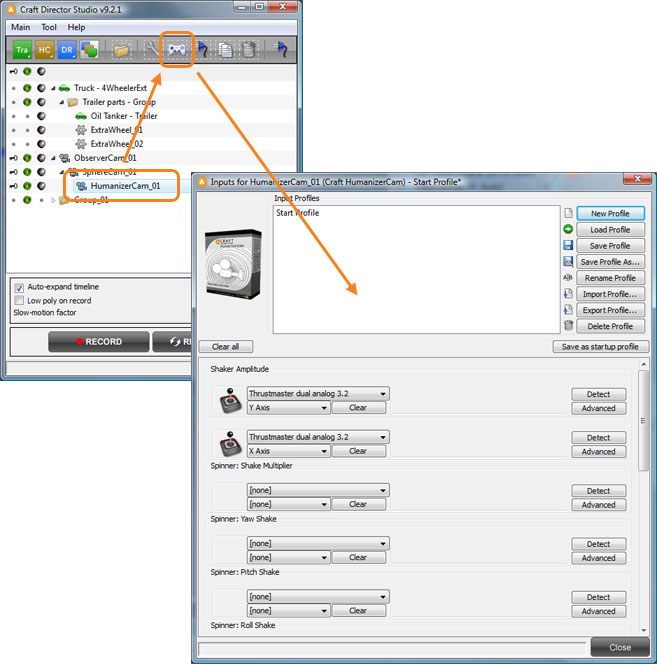
Using Craft MultiStateCam
 Optimizing the scene Optimizing the scene
It’s wise to optimize the scene before starting to recording the animation. The scene is optimized by decreasing the amount of polygons shown during the recording. This is achieved by hiding objects not crucial to the part of the scene to be animated. Another tip is to use Craft Bounding Poly, which temporary lowers the amount of polygons for selected objects and allows for a smoother recording. |
- Create a Craft MultiStateCam.
- Move the Craft MultiStateCam to the desired start position in the scene.
- Move the different states to desired positions.
- Configure the input settings for Craft MultiStateCam.
Select the Craft MultiStateCam in the tool tree list and click on the Input settings button in the tool bar. This will open the input settings window for Craft MultiStateCam.

- Configure the different WantedStates properties by editing them in the configure window.
Select the Craft MultiStateCam in the tool tree list and click on the Configure button in the tool bar. This will open the Configure window for Craft MultiStateCam.
- Optional: Align and link/parent the RelativeCage mesh to the moving machine/system for best possible movement.
- Change the viewport to MultiStateCam_CurrentState to be able to see the cameras movements.
- Click Record in Craft Director Studio’s main window to start recording.
- Use the Input controls you’ve configured to switch between the different states.
- Click Stop to stop the recording.
Input settings

01WantedState
This button will send CurrentState to 01WantedState.
02WantedState
This button will send CurrentState to 02WantedState.
xxWantedState
This button will send CurrentState to xxWantedState.
Spinner…
Spinners enables the change of parameter values with an input controller in real-time.
Configure
General Modes
Hide Helpers
Hides the Helpers.
Hide Helpers During Recording
Hides the Helpers during recording.
MultiStateCam Parameters
Use Simplified Settings
When checked the below settings will override the settings in the ##WantedState groups under them.
Maximum Translation Velocity
Sets the maximum speed of the CurrentState mesh. 0.0 will switch off the limiter.
Translation Response Factor
The smaller the value, the softer the CurrentState approaches the states. A value above the scene FPS yield an instant jump to the chosen state.
Maximum Rotation Velocity (Degs/sec)
Sets the maximum angular speed of the CurrentState mesh. 0.0 will switch off the limiter.
Rotation Response Factor
The smaller the value the softer the CurrentState approaches the states. A value above the scene FPS will yield an instant jump to the chosen state.
FOV Maximum Rate of Change (units/sec)
Sets the maximum FOV rate of change of the CurrentState camera. 0.0 will switch off the limiter.
FOV Response Factor
The smaller the value, the softer the CurrentState approaches its FOV value. A value above the scene FPS yield an instant jump to the chosen state.
Maximum Target Distance Rate of Change
Sets the maximum target distance rate of change of the CurrentState camera. 0.0 will switch off the limiter.
Target Distance Response Factor
The smaller the value, the softer the CurrentState approaches its target distance value. A value above the scene FPS yield an instant jump to the chosen state.
xxWantedState
Maximum Translation Velocity
Sets the maximum speed of the CurrentState mesh. 0.0 will switch off the limiter.
Translation Response Factor
The smaller the value, the softer the CurrentState approaches the states. A value above the scene FPS yield an instant jump to the chosen state.
Maximum Rotation Velocity (Degs/sec)
Sets the maximum angular speed of the CurrentState mesh. 0.0 will switch off the limiter.
Rotation Response Factor
The smaller the value the softer the CurrentState approaches the states. A value above the scene FPS will yield an instant jump to the chosen state.
FOV Maximum Rate of Change (units/sec)
Sets the maximum FOV rate of change of the CurrentState camera. 0.0 will switch off the limiter.
FOV Response Factor
The smaller the value, the softer the CurrentState approaches its FOV value. A value above the scene FPS yield an instant jump to the chosen state.
Maximum Target Distance Rate of Change
Sets the maximum target distance rate of change of the CurrentState camera. 0.0 will switch off the limiter.
Target Distance Response Factor
The smaller the value, the softer the CurrentState approaches its target distance value. A value above the scene FPS yield an instant jump to the chosen state.